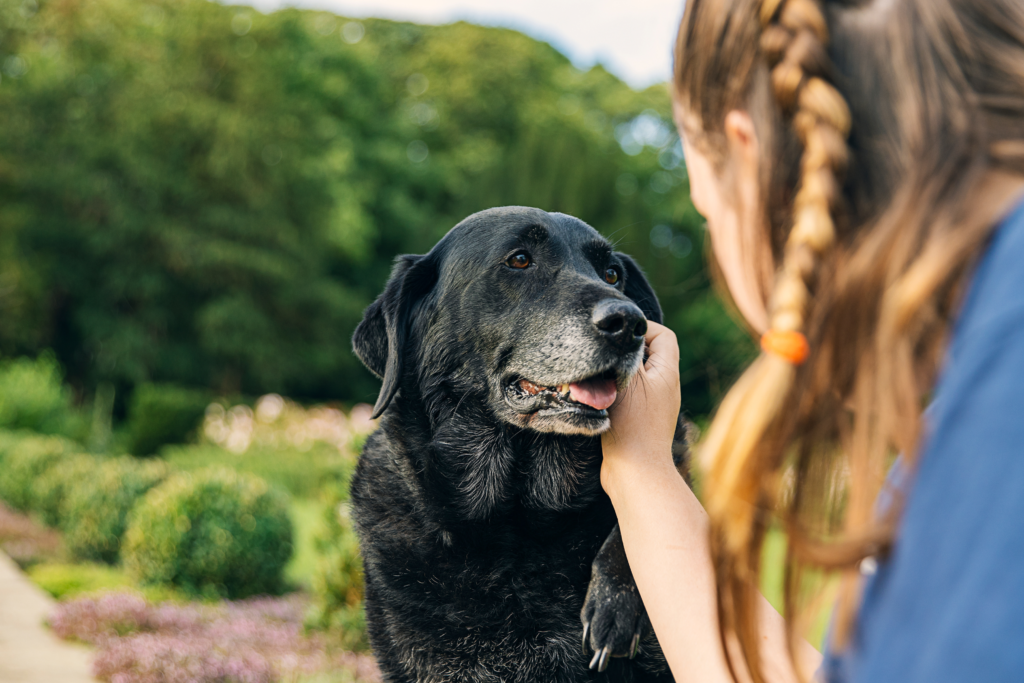Is Your Dog Losing Their Hearing? Signs to Spot and How to Help

Hearing loss in dogs is more common than many realize, affecting dogs of all ages and breeds. While we know dogs have a keen nose (they can wake up from a sound sleep to the smell of bacon), our furry sidekicks also have excellent hearing; think about when you open their favorite treat bag from a whole other room, and they come running! Having all their senses helps dogs navigate this world and even communicate with us, so it’s a big deal when one of their senses begins to fade or become non-existent. So, as responsible and caring dog owners, it’s essential to understand how to identify signs of hearing loss and learn how to care for a dog experiencing it. With National Deaf Dog Awareness Week taking place during the last week of September, now is the perfect time to shed light on this doggy topic.
You’ve got to hear this. Did you know, according to the American Kennel Club, anywhere from 5 to 10 percent of dogs in the U.S. experience deafness? So it is definitely something we should bring light to; we are going to take this opportunity to explore the causes, symptoms, and ways to support your furry friend with hearing loss, so that your loyal compadre continues to live a happy and fulfilling life, even as their world becomes a little quieter.

What Causes Hearing Loss in Dogs?
The leading cause of hearing loss in dogs is often old age. Much like humans, their hearing gradually deteriorates as they move into their senior years.
Other causes:
- Inflammation in the ear canal
- Ruptured eardrums due to deeper ear inflammation
- Trauma to the bones around the ears
- . Exposure to very loud noises nearby
- . Complications with certain medications
Hearing loss in dogs is generally gradual. You may not notice right away, but if you see some signs, it’s best to get your pet pal to their vet so they can do a little checkup and determine if they are experiencing hearing loss so you know what next steps to take.
Can You Hear Me Now? Common Signs of Hearing Loss
- Less awareness of surrounding sounds: Our dogs are just waiting to hear their name, or their favorite words come out of your mouth, like “walk or treat. ” So if they stop responding to some of these keywords or common commands or even every day sounds like the doorbell ringing or the squeak of their favorite toy, it might be a sign they are having a difficult time hearing.
- Excessive barking: We all can relate to our dogs barking at the things they aren’t the biggest fans of, maybe it’s the mail carrier or the pesky squirrel who keeps coming into their backyard. But there can be lots of barking for no apparent reason that could act as a sign of hearing loss. It could be caused by anxiety and frustration over not being able to hear.
 3. Deep sleeper: Do you find that when you’re getting ready in the morning or walking into the room in the afternoon, your dog sleeps through it all, continues snoring away, and is catching more ZZZs than usual? Another sign is that their hearing is not what it used to be if they sleep through the sounds of the world around them. If your dog sleeps through sounds that usually wake them, needs physical touch to wake up, or seems surprised when they do, these could be signs of hearing loss.
3. Deep sleeper: Do you find that when you’re getting ready in the morning or walking into the room in the afternoon, your dog sleeps through it all, continues snoring away, and is catching more ZZZs than usual? Another sign is that their hearing is not what it used to be if they sleep through the sounds of the world around them. If your dog sleeps through sounds that usually wake them, needs physical touch to wake up, or seems surprised when they do, these could be signs of hearing loss. - Being ignored: Are you feeling snubbed by your dog? Your furry bestie generally knows where you are at all times and even seeks you out. When we walk into a room, they usually are the first to notice you right away. If you find that they don’t seem to acknowledge your presence in a room or when you’re in the wayhouse they used to, it could indicate hearing impairment. They may not hear that you are home.
- Unusual behavior: Dogs that are losing their ability to hear can start to become confused by their surroundings, even in their own safe, secure home. This can lead them to be much more anxious or easily startled. They may also start shaking or tilting their heads in unusual ways as if confused and trying to locate or strain to hear sounds.
| Quick Ways To Test Your Dog’s Hearing At Home
Try creating these sounds while your dog is awake and asleep. Examine whether they turn their head toward the sounds, twitch their ears, or wakes from sleep.
|
 |
- Go to another room and the room they are in and see if they react when you call their name or make loud noises. Test the distance to see if they hear you when you are close, farther away, or not at all.
Showing some love, care, and empathy
As time passes, you might notice the signs of hearing loss becoming more frequent. Because we love and care for our furry friends with all our hearts, we often know them better than anyone else. As the attentive dog owner you are, recognizing changes in your dog’s behavior will likely lead you to suspect—and eventually confirm—that your pet is losing their hearing. To help your dog through this stage of life, we’ve outlined some ways to provide support. These small steps can create a more comfortable environment for your beloved companion and make them feel safe, supported and loved.
 1.Vet Check: First and foremost, schedule a visit to your veterinarian. They can determine the extent of your dog’s hearing loss and rule out any underlying medical conditions.
1.Vet Check: First and foremost, schedule a visit to your veterinarian. They can determine the extent of your dog’s hearing loss and rule out any underlying medical conditions.
2. Create Safe Environments: To provide a safe and comfortable environment for your dog with hearing loss, begin by making your home secure and free of unpredictable surprises like unexpected guests in your home (furry and not). Also, maintaining a steady schedule might help your dog feel less anxious; they can feel secure in what may happen throughout the day. Consider attaching a pet tracker to their collar or tying a bell to it so you can quickly locate them throughout the house and your yard. When outside, if your dog has been well-trained to return when called, you can still give them some off-leash time once they’ve learned hand signals. However, stay in open locations where you can clearly see each other. You might want to get a special collar that says “I am deaf” to make others aware that your dog has hearing difficulties, especially if you let them off their leash.
3. Avoid Startling Them: Dogs with hearing loss can startle more easily since they may not hear people or other animals approaching. To prevent this, increase physical touch to reassure and guide your dog. Gentle strokes and pats can communicate affection and help them feel secure. Whenever possible, approach a deaf dog from the front, especially when they’re resting. If your dog is lying on the floor, you can stamp your feet a bit harder to create vibrations they’ll feel, announcing your arrival. Switching the lights on and off a couple of times when entering a room can signal your presence without startling them.
| 4. Use Training Cues: Teach your dog to respond to hand signals rather than verbal instructions, and ensure consistency by using the same signals for each command. Vibration collars can also be useful, as they provide a mild vibration that draws your dog’s attention without scaring them. These collars do not deliver a shock but serve as a training or alert device. Be patient and provide lots of encouragement as your dog learns new ways to engage with their surroundings. It’s a learning curve for everyone. |  |
Raising Awareness
National Deaf Dog Awareness Week is an opportunity to educate ourselves and raise awareness about the challenges and rewards of living with a deaf dog. We can make a difference by sharing information with other dog owners, donating to organizations that aid deaf dogs, and considering adopting a deaf dog in need of a loving home. Hearing loss in dogs can be tricky for both pets and humans, but with the correct understanding and tools, you can help your dog adjust and adapt. This week presents a fantastic opportunity to ensure that every dog, regardless of hearing ability, receives the love and care they need.
And with that, check out this short video that will bring a huge smile to your face. This video is a reminder that “love doesn’t need words.”